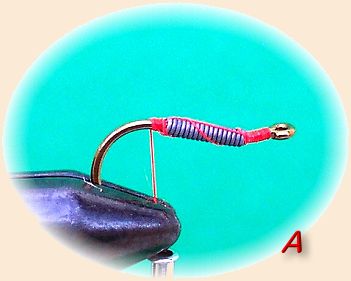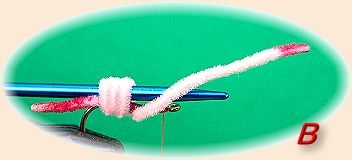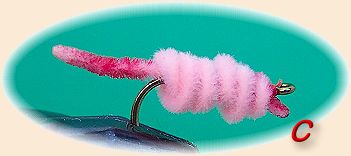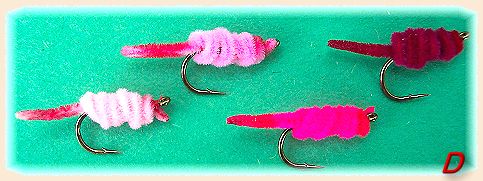Drifting Oligochaete Worm
By Fox Statler (Mr. Sowbug), Salem, AR
Could Every "San Juan Worm" Ever Been Tied Be Wrong?
I bet you are all saying, "This guy has lost it."
Am I crazy? Nope. In June I had a guide trip with
Ray Askins from Mansfield, Ohio and his son Mark
from Kansas City. At least twice a year for the
past twenty years I have guided Ray and Mark. Ray
is 82 years old, a good fisherman, a wonderful person,
and a great companion. Mark is an intelligent, gentle
man with a clean sense of humor. People like these two
make guiding enjoyable. Because of Ray's age, I wade
fish him only in gravel that is as flat as a parking
lot. I admire his courage. Every year he insists on
wading one day or at least part of a day.
On this day we were fishing at the Norfork Dam pool
on the North Fork of the White River in north central
Arkansas. The water seemed to be colder than other years
and the gravel was caked over with an inch thick crust
of olive-brown, dead algae. The fishing was slow, but
the fish were good size. The fly had to be dragging
on this yucky algae in order to get a strike.
We were using a dark gray "Planarian" imitation dropped
under a "White River Dead Drifter Sowbug" and catching
fish 14-17 inches long. Ray and Mark were enjoying
themselves and I did not want to interrupt their visit.
I was busying myself with the awful algae on the gravel.
I had backtracked our trail into the water and noticed
that the fish were feeding wherever the algae crust was
broken by our boot tracks. The water was about 18 inches
deep and a large flake of the algae had floated downstream
from where it had been disturbed. I placed my boot next
to it. Then I yanked my foot up quickly trying to create
an upwards current that would carry the algae chunk near
the surface where I could capture it without getting too
wet. The algae chunk disintegrated from the sudden current,
and a pink object caught my eye. Quickly I thrust my hand
into the water below the object and let it descend into
the palm of my hand. Slowly raising it out of the water,
I realized I had captured a worm as it began to crawl about.
I dropped it back into the water and something very strange
happened. I caught the worm again hurriedly. I dropped it
again. I must have done this 10 or 15 times, each time the
same thing happened. Letting that worm go, I quickly found
another one to test. I dropped it and the same strange
thing happened again.
Ray and Mark decided to quit early. After the goodbyes
and the "I'll see ya in the fall," I returned to the
water to investigate my worms. I caught about 50 worms
in the next two hours and believe it or not, they all
did the same thing. I borrowed a worm from a bait
fisherman but his worm acted differently than the
worms in the river. I had never heard another fisherman
mention what I had seen. I headed home to research my
worms on the internet. I knew I had discovered something
that could change worm fishing forever.
Once home I brought the computer up, hit the favorites
for "www.google.com" and typed in "aquatic worms." I read
and read and read but nowhere was there a mention of what
I had seen. I read about what lives in tailrace waters of
Arkansas. I found there are over a hundred specie of aquatic
worms. Some even have eyes. The worms that live in our lakes
and rivers are called "Oligochaete" (ol-i-go-ket). For some
reason, I like the ring of that word. I learned that these
worms live in rivers that are considered to be "Organically
Polluted" waters. My search taught me that biologist know
this because of the aquatic insects and worms that are found
in my rivers. I read on, I discovered that the problem of
organic pollution will increase as the lakes above our rivers
become older and more stratified. And finally, I learned that
as the diversity of insects and worms disappear in our rivers
the more serious the organic pollution becomes.
I live in Arkansas by choice. The lakes, streams, and
rivers in this state are my joy. I never cared to travel
west and fish such rivers as the Yellowstone, the Madison,
etc. Why? As for fish, they don't raise them bigger than
they grow in Arkansas. Dry fly fishing is not my passion.
Nymphing and streamer fishing is the ultimate for me
personally. Somehow I got a lot of Boston Mountains'
water in my blood, probably by osmosis. It makes me
angrier to have a cow take a dump in my streams than
any insult you could give me. I would rather save a
half mile of any stream in the Ozarks than all the
rivers in Montana. You bet I'm selfish! I hope you
are too! We should all take care of what is ours first
before we try to save the rest of the world.
There has been a lot of talk about what some people
consider to be signs of ecological disaster in our
Arkansas rivers. Truthfully, it is just "so-much-poop,"
"bull-hockey," garbage. The bugs in our rivers are the
best indicators of the changes that are taking place,
as they are in yours. The more one sided and less
diverse the selection of bugs becomes the more problems
we all will have. Have you looked in your favorite river
lately?
After guiding on the White River and North Fork of
the White River for over twenty years, here are some
of my observations: Several islands and gravel bars
in the river are gone or have moved down stream. This
is normal. The banks of the rivers are still deteriorating.
This will not stop until the Corp of Engineers change
their method of running the river. This may never happen.
Until then I am thankful for the landowners who preserve
the banks with limestone rocks. Coon-tail Moss is still
growing in the silted areas of the rivers. It is a remnant
from when the rivers had warmer water. Sowbugs may be on
the decline in the North Fork but scuds, caddis, craneflies
and mayflies are on the increase. This is good. The same
is true of the White River. In the White River, the scuds
have changed color from a red-brown to dark-olive over
the years because of the increased algae that is present
on the river gravel. The White River has changed from a
yellow and brown gravel bottom river to a light and dark
olive bottom. The fish are generally smaller and presently
there are fewer throughout the White River system below
Bull Shoals Dam. The hatchery at Spring River is being
renovated which adds to the present problem. As for smaller
fish, we need better regulations and to give more power and
authority to our AG&FC Officers. In my opinion, we need to
replace a couple of State Representatives, a Judge in this
area, and one or more commissioners of the AG&FC that don't
believe in catch-n-release. Plainly said, plainly the truth.
We need to be more concerned about what is happening to the
water in our upstream lakes. Pollution here translates into
long term problems in our rivers. The people who live on the
banks of our streams and lakes are the main polluters of our
waters. We need to be continually watchful of them. Every
septic tank adds to the pollution problem. We need to become
more "Progressive" in our thinking instead of the "Reactionaries"
we are now.
Back to my Oligochaete Worms. The adult worms in my river
are 3 to 4 inches long and about an eighth of an inch in
diameter. They are shell pink to cerise on the main
portion of their bodies and have a bright red tint on
the ends due to the collection of blood vessels at the
hair-fiber breathing apparatus. A mud line can be seen
under their skin which changes color depending upon the
type of dirt that they are found in. In most cases the
mud color is a dark gray.
I once watched a program on the behavior of worms
on the Discovery Channel. Ancient worms searched
for food randomly, while the more advanced modern-day
worms search methodically. What is the difference
between an Oligochaete worm and an Earthworm?
Oligochaete drowns in air and an Earthworm drowns
in water. Do they exhibit different behaviors in
the same situation? Yes. When you drop an Earthworm
in water it tries to wiggle free of it. Oligochaete
do not. Instead they coil up like a corkscrew with
a short tail and fall to the bottom quickly, then
disappear into the gravel, mud, or debris on the
bottom. This is what I saw. As long as the Oligochaete
Worm is falling or moving in the water column it is
coiled up tight like a spring or corkscrew with a short
tail. Once it stops moving it quickly crawls away. So
not all of the San Juan Worms are tied wrong, just the
ones you fish in fast water. I don't know if the aquatic
worms in all rivers and lakes exhibit this behavior.
But I am lead to believe that if a particular specie
of worm is within a river system, then it can be found
throughout that entire system. This would mean that the
Oligochaete Worm I observed would be throughout the
Mississippi Drainage system.
Strangely without knowing it, our fathers taught us
a valuable fishing lesson. Hook the worm on the hook
several times. We did this to keep from loosing the
worm so quickly. We didn't know that it was a better
imitation of an Oligochaete Worm. Thanks Dad for
taking me fishin'.
What I observed has brought about several changes
in tying the worms I fish on the White River system.
Now instead of tying a single colored worm, I always
color the ends with red permanent marker pen. Because
of the shape that the Oligochaete worm assumes when
not on the bottom, it is easy to add weight. Different
amounts of weight can be added to get the worm near
the bottom in fast water. When fishing high water
caused by a heavy generation cycle of the dams, I
use a worm with as many as ten wraps of .035 lead
wire. This is enough weight to replace the "BB"
split shot which was placed about eighteen inches
above the worm I had been using. During low water
periods, I generally prefer patterns with six to
eight wraps of .020 lead wire. However, I do carry
a few worms that have no weight in them. I use these
when dropping a worm under another weighted fly.
The realization of what an aquatic worm caught in
the current looks like has also brought about an
understanding of why some controversial patterns
work. The first of these is a large egg pattern
that is successful when no spawning is occurring
in the river. Fluorescent shell pink eggs with a
red spot in them are a favorite among egg patterns.
Pink jigs are another such pattern. What do they
really imitate? Probably a flesh pattern. However
the flesh of most fish is a whitish-pink. The flesh
of trout may be shell pink in color, but there are
never enough decomposing or shredded trout in the
our rivers to warrant the productive abilities of
pink jigs. Another question is also answered because
of behavior of the Oligochaete worm. Browns are rarely
caught in the heavy generation cycles on worms. Browns
being as particular as they are would have no problem
recognizing that a San Juan Worm is not in its environment
during these periods. The San Juan worm is a good imitation
of an earthworm that has been washed into the river by
rain and bank deterioration. I have often noticed how
productive a San Juan is after a heavy rain. But when
the weather is dry, San Juan's are a moderate producers.
Here is my imitation of an Oligochaete Worm, they are
simple and versatile. ~ Fox

Materials List Drifting Oligochaete Worm:
Hook: 2170 series Daiichi Bent Shank hook, sizes #12 - #4.
Thread: Red or Fluorescent Red 8/0 Uni-Thread.
Lead Wire: None to 8 -10 wraps of .035 lead wire
depending upon the amount of lead wire need to get the
worm down into the current well.
Body: Ultra Chenille, small to medium, length 3 to 4 inches.
In colors of Fluorescent Shell Pink, Fluorescent Pink, Fluorescent
Red, Shrimp Pink and Wine.
Marker: Red Prismacolor Pen or Red Permanent Marker Pen.
Instructions - Drifting Oligochaete Worm:

Step #1: Place the hook in the vise. Wrap the
amount and size of lead desired in the middle
of the shank of the hook. Start the thread at
the eye of the hook. Wrapping toward the bend
of the hook, tie down the lead (if used). End
up at the beginning of the hook bend. Cover the
thread wrappings with a light coat of glue.

Step #2: Cut the desired length of Ultra Chenille
for the body. Color the last 1/4 Inch of each end
lightly with a red pen. Tie in the Ultra Chenille
at the beginning of the hook bend leaving a 1/2 to
3/4 inch tail. Wrap the thread forward to the middle
of the lead. Loosely wrap the Ultra Chenille to this
point and tie down with two wraps of thread. To make
the wraps uniform, use a small knitting needle or
toothpick.

Step #3: Wrap the thread to the eye of the hook.
Loosely wrap the remainder of the Ultra Chenille
to the eye of the hook. Tie down the Ultra Chenille.
Whip finish and glue the threads of the head.

This pattern is a great imitation of an Oligochaete
Worm caught in the current. Only one thing is missing;
the mud line. If Ultra Chenille was constructed with
iron-gray or black threads in the center, this pattern
would be a perfect representation. I have discovered
that Oligochaete Worms work extremely well in fast
water for trout, smallmouth, and other specie of fish.
I generally start the morning using a fluorescent red
worm. Change to the fluorescent pink by mid morning.
Fluorescent shell pink or shrimp pink for midday.
Follow these colors in reverse for the afternoon
and evening. The wine colored worm works well on
very cloudy days from mid morning to mid afternoon.
The reason the colors of the worms that work well
changes during the day is due to the angle of the
sun, cloud cover, and the color of light that is
penetrating the water. This is also true of San
Juan Worms and Jigs.
~ Fox
About Fox:
Fox is a retired educator, fly designer for Spirit River, guide
and author of Fishing What They See,
available on his website,
www.fishinwhattheysee.com.
|



